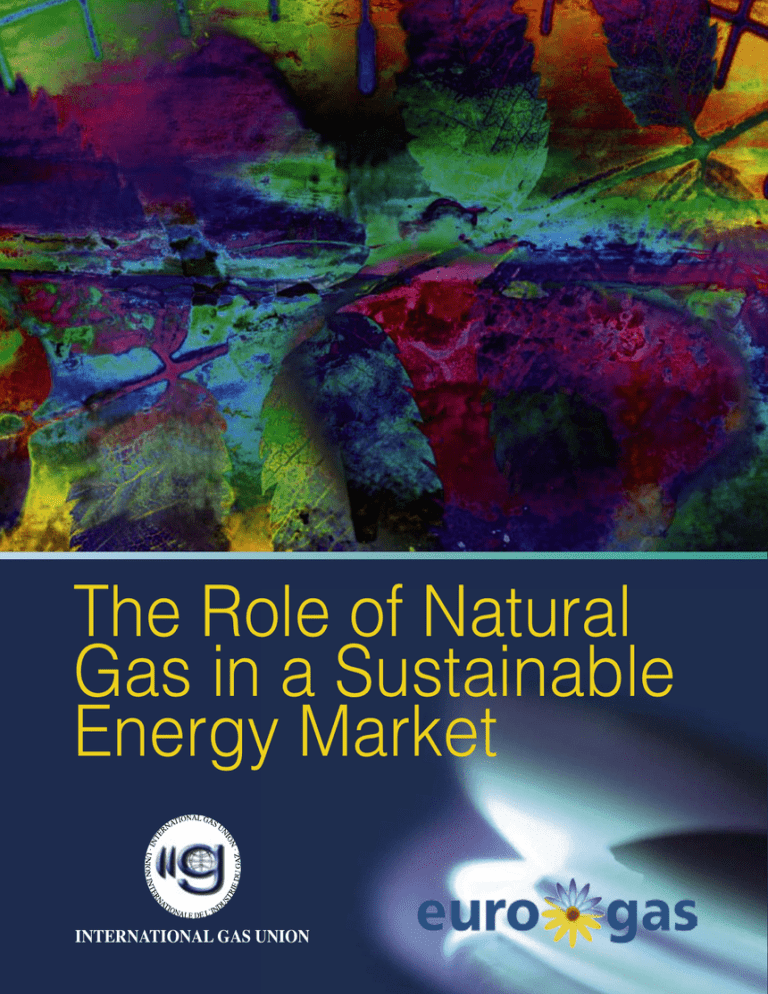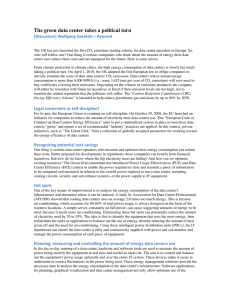The Role of Natural Gas in a Sustainable Energy
advertisement

The Role of Natural Gas in a Sustainable Energy Market INTERNATIONAL GAS UNION 5 THE ROLE OF NATURAL GAS IN A SUSTAINABLE ENERGY MARKET 4 1 FOREWORD The concentration of CO2 in the atmosphere is soon set to pass through the 400 ppm mark. Most climate scientists consider that this represents an unacceptable chemical experiment with the earth’s atmosphere. Climate change challenge means we have to make the most efficient use of all available energy sources. Natural gas, a cleaner burning fuel than coal and oil, offers solutions to the world’s economic and environmental challenges in a secure and sustainable way. With natural gas, we do not have to wait for new technical inventions to help to solve the problem. For example, by replacing five coal-fired plants with five gas-fired plants, we can immediately achieve the same volume of CO2 emission reduction as with 9,000 MegaWatts of new wind power. The challenge for environmental and energy policy makers is to create a framework within which natural gas can play its full and important part of the energy mix. It is in all our interests that we make short-term progress towards solving urgent problems. Moreover, natural gas will continue to contribute to low carbon solutions in the very long term. Through its flexibility natural gas can complement the variations in wind-generated electricity and solar heating in the home and office. Natural gas will enable these sources of carbon-free energy to make a bigger contribution to people’s energy needs than they otherwise could. Natural gas is an ideal partner for a low carbon future. And natural gas can be with us for a very long time. The reserves of gas that we already know about, in conventional reservoirs, will provide enough to meet more than 60 years of demand at today’s consumption rates. And our companies find more of this conventional gas every year - usually replacing each year’s use with the same amount of new discoveries. What’s more, we now have reliable ways of producing gas from rocks where it used to be considered inaccessible. We do not yet really know how much of this ‘unconventional’ gas is contained in shales around the world, but we do know that shale rocks are much more widespread than the sandstones whose reservoirs have provided gas for the past 100 years. Natural gas offers solutions to the world’s economic and environmental challenges in a secure and sustainable way. Natural gas is the cleanest of hydrocarbons, easy to control and efficient in distribution and use. Jean-François Cirelli President of Eurogas Datuk (Dr) Abdul Rahim Hashim President of International Gas Union Torstein Indreboe Secretary General of International Gas Union 5 3 1. Natural Gas is contributing to a more sustainable world Economic growth and increase in population worldwide implies a strong increase in world energy demand. In regions with high rates of population growth, still industrialising or developing, like Asia and South America there will be a need for energy that improves the local environment with the least possible impact on global emissions. This growth in energy demand will for many years to come have to be met by hydrocarbon fuels. At the same time, because of climate change, which today is considered one of the biggest challenges facing mankind, efforts have to be directed in all parts of the world towards achieving a low-carbon energy mix. Climate researchers believe the only way to limit the rise in global temperatures by a tolerable 2°C is to halve global emissions of greenhouse gases in the long term, with the industrialised world playing a leading role. Worldwide, natural gas has a key role in meeting this objective. With its low carbon emissions compared to the other available fossil fuels, natural gas provides a solution to the world’s economic and environmental challenges in a secure and sustainable way. It is the fuel of choice for energy efficiency, and is the cleanest of the hydrocarbons: • When burnt to heat homes or for industrial uses, it releases 25-30% less CO2 than oil and 40-50% less than coal per unit of energy produced. • When burnt to generate electricity, it releases around 60 % less than coal for every kWh sent out. By replacing five coal-fired plants with five gas-fired plants the same volume of CO2 emission reduction can be reached as with 9,000 MegaWatts of new wind power. • Natural gas also produces little nitrogen oxide, sulphur dioxide or particulates 4 2 3 2. Natural Gas consumption is projected to double worldwide by 2030 due to expected growth in energy demand Natural gas has significant environmental advantages as an energy source. Worldwide proven reserves of conventional gas alone total 187.49 trillion m³ with a reserve production ratio of more than 60 years. Furthermore, worldwide unconventional gas potential is boosting available reserves which may extend current production by a century or more. Today, the unconventional gas potential, such as shale gas and coal bed methane (CBM), is mainly to be seen in the United States but the shale and CBM resources of other parts of the world are only now being technically and commercially available. With shale gas meeting a large share of the US energy needs, there is now more conventional gas available to diversify supplies for Asia, Europe, and the developing world. 5 3. Natural Gas can be transported across the globe with minimal environmental impact Natural gas requires little processing between the source where it is extracted and the end customer. Natural gas has become a global commodity and can be transported safely and efficiently in its liquefied form (LNG) by specially-designed LNG tankers, or delivered from country to country, and even across continents, via a network of pipelines. It can be transported and delivered very efficiently in these ways over both long and short distances, with minimal fuel losses during transportation. 4 4 6 5 4. N atural Gas is the most efficient fossil fuel in conventional power generation The share of natural gas in the power generation sector is 22 %* worldwide. This share is expected to increase due to the overall aging of power plants and the need for replacement worldwide. 6 Transport in gaseous form through pipelines and storage in caverns are unobtrusive for the environment and population, as they are usually installed underground. During the laying of pipelines, special care is taken to ensure minimal impact on the local flora and fauna. Particular attention is also paid to restoring the surrounding area to the original ecology and landscape, to preserve the local biodiversity. 7 Natural gas has a higher conversion efficiency leading to lower loss of energy than other fossil fuels when producing electricity or heat. Among the other advantages of natural gas-fired power stations are: • comparatively low costs, • speed of construction and • flexibility in use With natural gas, at this stage process can be used in generating electricity. A first gas driven turbine works like a jet engine making electricity as the blades spin. Then we take the hot gases - the ‘jet’ that comes out at the back of the engine - to make steam that turns another turbine, making more electricity with less waste. This is called a ‘Combined Cycle Gas Turbine’ (a ‘CCGT) and nearly all new gas-fired power stations everywhere in the world are built this way. Replacing an old coal-fired plant with a CCGT can reduce the CO2 emissions by up to 70%. In the future, carbon capture and storage (CCS) may reduce CO2 emissions from gas-fired plants yet further. In addition, combined heat and power (CHP) applications use the rest of the lower tempe­ rature waste heat (which cannot be used for further electricity production) to supply heat to neighbouring customers. The efficiency of a CHP plant can be as high as 90%. Gas can be used in this way not only in CHPs, but also in industrial and commercial applications, and to heat nearby homes. *OECD/IEA World Energy Outlook 2009 5 7 5. Natural Gas enables Renewable Energy Sources (RES) due to its flexibility Natural gas generation can be switched on and off quite quickly, making natural gas-fired generation the fuel of choice to accommodate sudden changes in electricity demand or supply. This is especially important in countries where there is a lot of wind and solar energy, which are intermittent renewable sources. Houses for example can be heated and their hot water provided by a combination of high efficiency gas-fired appliances (such as micro turbines) and solar power. In this way, natural gas complements the environmental attractiveness of renewables, while ensuring continuity of energy supply for the user. 4 8 6. G as can turn a key to the house of the future BIOGAS 9 Today, natural gas-fired applications offer highly efficient solutions to the needs of domestic, commercial, and industrial customers. Using high efficiency boilers (which are around 90% efficient) is more than twice as effective in terms of reducing carbon emissions as converting the gas into electricity and using it for space heating, once electricity network losses are taken into account. Also biogas brought up to the quality of natural gas can be added to natural gas transported in the pipeline network. This is often referred to as “green gas”. The biomass used to produce biogas should meet sustainability criteria, or alter­ natively some waste materials can be appropriately processed and used to pro­duce biogas. Natural gas can also be blended with hydrogen. Gas-fired applications in the houses of the future, moreover, promise even more advantages. Micro CHP, or gas-fired fuel cells and also gas-fired heat pumps will heat as well as produce electricity in low-emission buildings. Japan, the Netherlands and Germany have come far in the Micro CHP technology development and implementation. Surplus electricity can also be sold contributing to decentralised electricity production. 10 5 9 8 7. Natural Gas can make an immediate contribution to reducing greenhouse gas emissions in the transportation sector Natural gas should have an increasing role in transportation. There is general consensus that use of dedicated Natural Gas Vehicles (NGVs) results in 20% to 25% less CO2 emissions compared to petroleum fuels, thus contributing to cleaner and healthier ambient air. This is especially welcome for urban areas, making natural gas ideal for community fleet vehicles like buses or refuse collection trucks. More and more passenger vehicles, moreover, are running on natural gas. 11 12 13 14 Recent development in use of LNG as fuel for ships will further help reduce emission of greenhouse gases in the marine sector. Switching from diesel to natural gas has at least a 20% C02 reduction potential and is being pursued as a measure for inland ferries and offshore supply vessels (source: IGU Publication: Natural Gas Unlocking the Low Carbon Future). Also local environmental concerns (e.g NOx and Sox) in harbours and along coastlines including new rules from the International Maritime Organisation (IMO) supports increased use of natural gas in the transportation sector. 10 4 The International Gas Union (IGU) as founded in 1931 and is worldwide non-profit organisation aimed at promoting the technical w and economic progress of the gas industry. The Union has more than 100 members worldwide in 73 countries on all continents representing approximately 95 % of the world gas market. IGU is organising the World Gas Conference (WGC) every third year. The IGU has increased its focus on geopolitics and energy strategy. Recognising that natural gas has an important part to play in satisfying the global need for an environment-friendly energy source, the IGU will be the most influential, effective and independent non-profit organisation, while serving as the spokesman for the gas industry world-wide. The members of the IGU are national associations and corporations of the gas industry worldwide. The IGU’s working organisation covers all aspects of the gas industry from exploration and production, storage, LNG, distribution and natural gas utilisation in all market segments. For more information, please visit www.igu.org EUROGAS, the European Union of the Natural Gas Industry is a non-profit organisation governed by the Belgian law. The offices are located in Brussels. The organisation is composed of 48 members from 28 countries amongst which 34 natural gas companies, 12 federations of natural gas companies, and 2 international organisations. The objectives of the organisation are: • to promote the interests of its membership, companies, national federations and associations involved in the supply, trading and distribution of natural gas and related activities such as storage and liquefied natural gas. • to promote the development of natural gas in Europe particularly in the legal economic technical and scientific areas to prepare studies and to promote cooperation within the gas industry. • to promote the smooth functioning of the European internal gas market and to take stance on issues of interest to the European natural gas industry with respect to international and supra-national organisations including but not limited to the European Institutions and to public opinion. For more information, please visit www.eurogas.org 11 5 INTERNATIONAL GAS UNION 4 IGU - International Gas Union · c/o Statoil 0246 Oslo · Norway Tel: +47 51 99 00 00 www.igu.org The European Union of the Natural Gas Industry Av. de Cortenbergh, 172 - Box 6 B - 1000 Brussels Tel: +32 2 894 48 48 www.eurogas.org Editor: S. Basiu, Eurogas • Concept: Studio A4 • Printing: DB Print. Photos courtesy of: www.energypicturesonline.com (cover photo, 3,10, 13, 14) www.fotolia.com (1, 2, 8), E.ON Ruhrgas (4, 9), Gas Natural Fenosa (5, 6, 7, 11), A typical NGV refuelling station in Malaysia (12)



